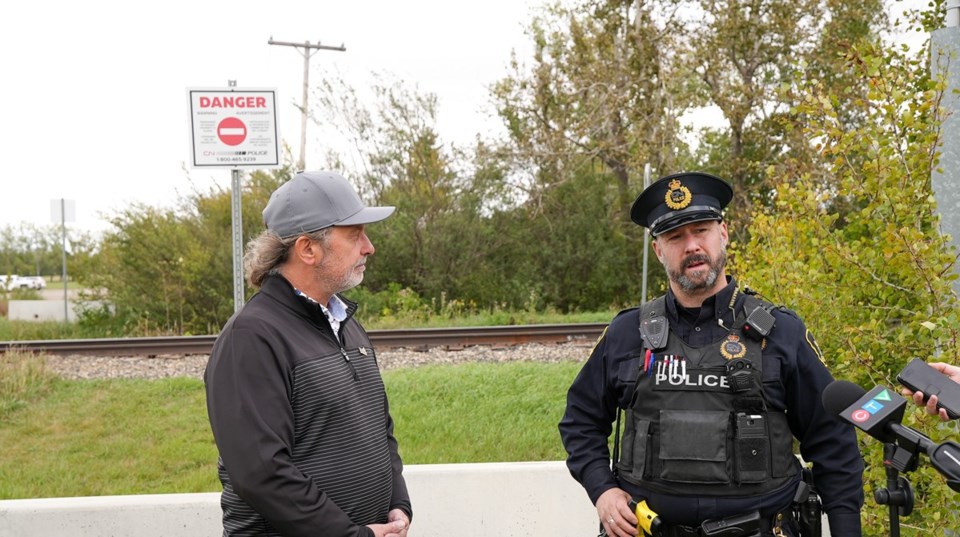YORKTN - It's Rail Safety Week in Canada, and Tuesday Const. Henry Neumiller of CN Police was in Yorkton meeting with Mayor Mitch Hippsley to discuss the week.
Neumiller said it was one stop on a week-long itinerary where he would be “encouraging rail safety education with (area) communities.”
For example, Neumiller had already held a session with CN staff in Melville, was heading to Regina Wednesday, had a school visit to Punnichy planned, as well as stops at area grain handling facilities to talk to commercial drivers.
“Commercial drivers are a high risk group,” he explained, adding they put a lot of miles on, and when handling farm products are usually delivering near rail tracks.
This year the provincial Ministry of Highways and the Canadian Safety Train Express are reminding everyone: See Tracks? Think Train!
"Railways in Saskatchewan are a vital part of our transportation network, ensuring our food, fuel and fertilizer moves around the globe," Highways Minister Jeremy Cockrill said in a recent release. "We urge all Saskatchewan residents to be aware of the risks associated with railway crossings and protect themselves and their families."
"Rail is a vital mode of transportation throughout Saskatchewan and we want to remind everyone to be extremely careful around tracks and trains," Canadian Safety Train Express CEO Perry Pellerin said in the release. "It's not a play area and drivers need to constantly be aware of locomotives at crossings throughout the province."
Rail Safety Week raises the profile of rail safety in Canada, with education aimed at keeping everyone safe at railway crossings and rights-of-way.
Neumiller said this year people appear to be reminded to take care around rail lines and trains. He said while only a few years ago accident numbers appeared in decline, things have turned the wrong way coming out of the COVID shut-down of many activities.
“2022 is a very different year as far as rail accidents in Saskatchewan are concerned. In the first six months of this year we’ve had almost as many incidents as in all of last year,” he said, adding this year there have been deaths too.
In analyzing the incidents, Neumiller said this year in each incident the vehicle driver had been in error, adding the CN Police don’t look to assign blame, but rather seek to understand the reason for the incident so they can work to prevent a repeat at the location.
Neumiller said the key is for drivers to be aware that trains can be dangerous, and to be cautious.
For example;
· Any time is train time! Trains do not always run on schedule. They can run at any time, on any track, and come from any direction.
· Speed Misperception: Because of their size, trains appear to be much further away and traveling much slower than their actual speed. Don’t be fooled!
· Trains can’t stop quickly. The average train needs at least 2 km / 1.25 miles to stop.
Pedestrians also need to be diligent.
For example; flashing red lights mean that a train is approaching.
Do not walk around or behind lowered gates at a crossing and never cross the tracks until the lights have stopped flashing.
Today’s trains are very quiet – you may not hear one if you’re listening to music, talking to your friends, or focused on your phone. Even though trains whistle at most crossings, you won’t hear them if you’re wearing headphones. Around train tracks or in stations, obey all warning signs and signals and use caution when using headsets or cell phones.
Stay off the tracks!
Taking a shortcut across the tracks or being on railway property is illegal, and trespassers can be seriously injured or killed.
Do not drive around lowered gates: it’s illegal and can be deadly. If you think that a railroad signal may be malfunctioning, call the emergency number posted on or near the crossing signal, or your local law enforcement agency.
If your vehicle ever stalls on railroad tracks, get out and move away from the tracks, even if you don’t see a train.
Find the Emergency Notification System sign and call the number provided to inform them about the stalled train.
If you choose to walk or play around railroad tracks, you are trespassing on private property. Consequences can range from fines to fatality.
The only safe place to cross railroad tracks is at a designated public crossing. Railroad tracks, trestles, yards, and equipment are private property.
Follow directional signs and markings that let you know where it is safe to cross the tracks. Crossing the tracks anywhere else is dangerous and illegal.
Saskatchewan has 13 operational, privately-owned shortline railways. These operate on more than 2,000 kilometres of track and connect to more than 6,000 kilometres of federally-regulated track.
Motorists with any questions or concerns regarding railway safety, signage, work zones and more are welcome to reach out to the Highway Customer Service Centre at 1-844-SK-HIWAY, Monday - Friday, 8 a.m. to 5 p.m., or visit us online anytime.



.JPG;w=120;h=80;mode=crop)


